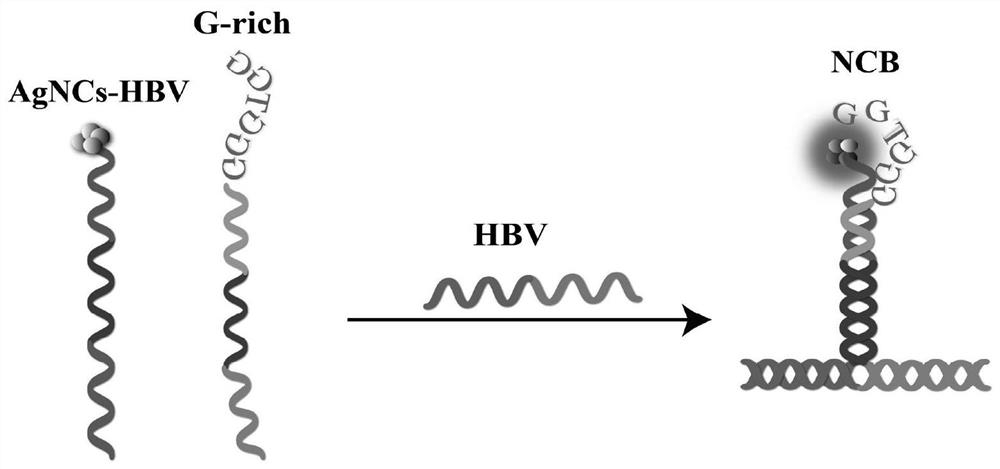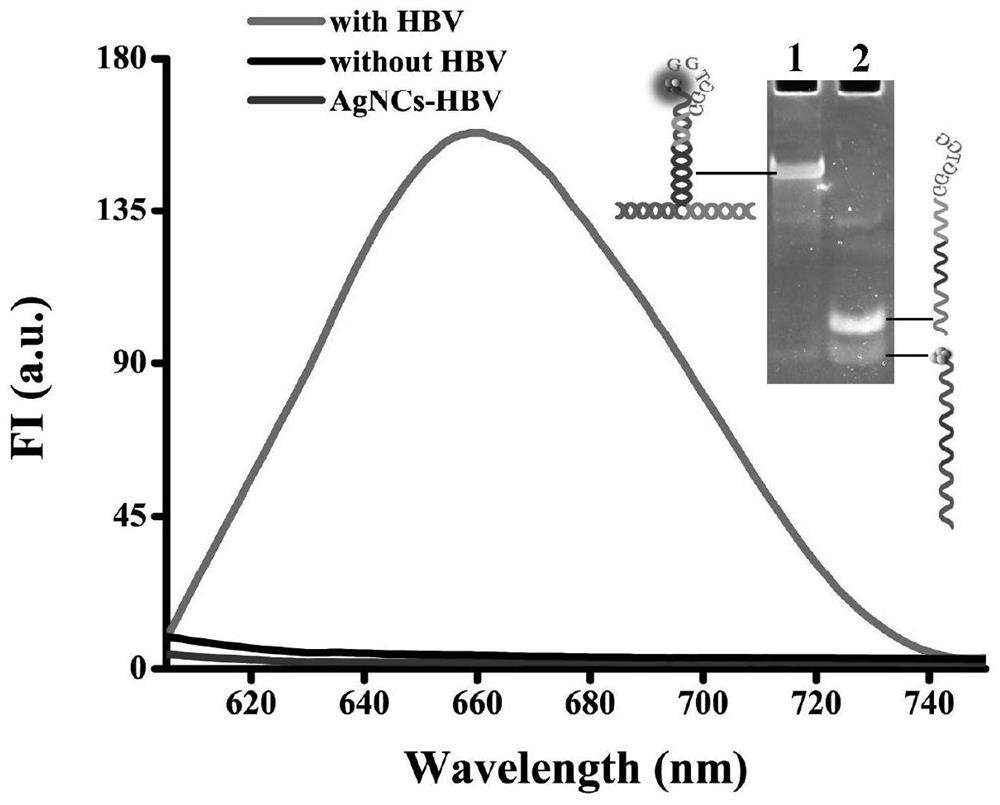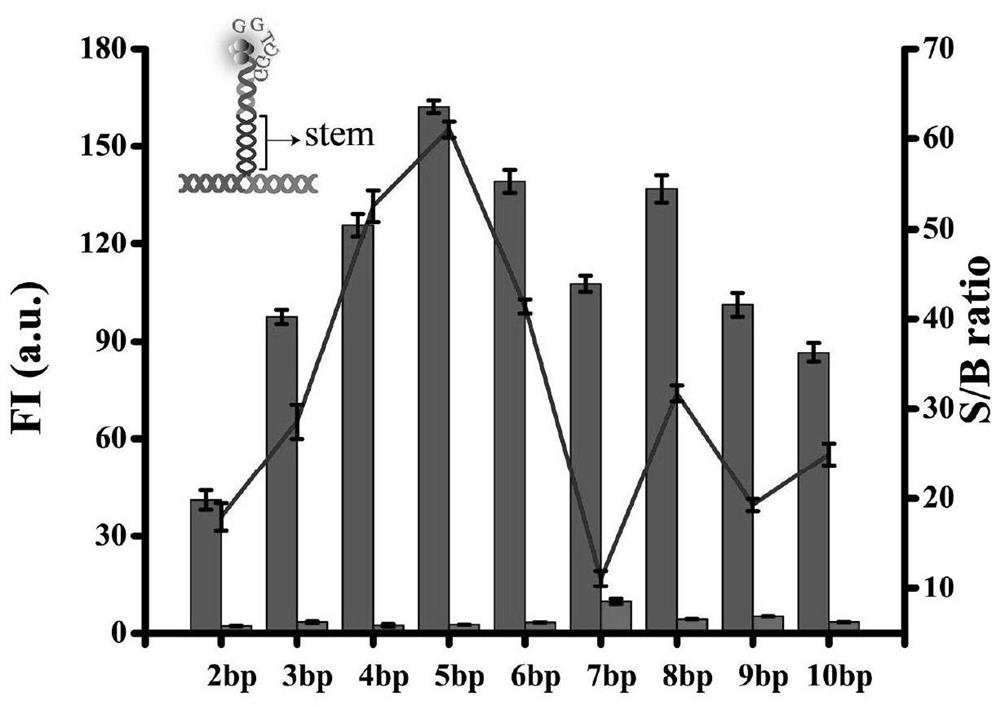Probe and fluorescence sensor for quantitatively detecting hepatitis B virus DNA and method
A fluorescent sensor, hepatitis B virus technology, applied in the direction of recombinant DNA technology, DNA / RNA fragments, fluorescence / phosphorescence, etc., can solve the problems of high cost, poor stability, cumbersome operation of HBVDNA detection methods, etc., to achieve low cost and expand Effects of detection versatility and low synthesis cost
- Summary
- Abstract
- Description
- Claims
- Application Information
AI Technical Summary
Problems solved by technology
Method used
Image
Examples
Embodiment 1
[0052] Fabrication of fluorescent sensors and detection of DNA
[0053] 1. Materials and methods
[0054] 1.1 Materials
[0055] HPLC-purified oligonucleotides were synthesized by Shanghai Sangong. AgNO 3 and NaBH 4 Purchased from SIGMA-ALDRICH Co., Ltd. (St. Louis, USA). PBS buffer (20mM, pH 7.0) was purchased from Shanghai Sangong Company.
[0056] 1.2 Testing instruments
[0057] The Cary Eclipse fluorescence spectrophotometer is a product of Agilent.
[0058] 1.3 Detection principle
[0059] figure 1 The detection principle of the present invention is shown: in a homogeneous system, the target substance, the first probe enhanced sequence G-rich and the second probe DNA silver nano-cluster sequence AgNCs-HBV form a three-stranded structure, and G-rich can Enhanced fluorescent signal of AgNCS-HBV. The content of the target substance can be known by detecting the fluorescent signal.
[0060] The nucleotide sequence of G-rich is:
[0061] 5'-TCCATATAACTTCGCATGGGTGG...
Embodiment 2
[0079] Validation of the feasibility of a fluorescent sensor for the detection of HBV DNA
[0080] In embodiment 1, the overall detection process is verified with page electrophoresis fluorescence detection, and the results are as follows figure 2 shown.
[0081] figure 2 Shown are the comparison graphs of fluorescence signals and electrophoresis graphs (insert graphs) to verify the feasibility, in which the red curve is the experimental group, the black curve is the control group lacking the target substance, and the blue curve is the control group with only AgNCs-HBV; figure 2 The insert figure in is the electrophoresis verification figure, in which lane 1 is the target substance, and lane 2 is AgNCs-HBV and G-rich.
[0082] Depend on figure 2 It can be seen that when only DNA silver nanoclusters exist, the fluorescence signal is extremely low; when there is no target substance, the nanocluster probes will not self-combine to generate fluorescent signals; when the tar...
Embodiment 3
[0085] Fluorescence sensor for detection of HBV DNA and optimization of its application conditions
[0086] In this embodiment, several important conditions in the experimental process are: the number of stem bases combined with triple strands; the reaction temperature of G-rich and AgNCs-HBV hybrid system, the reaction time of G-rich and AgNCs-HBV hybrid system; DNA, The configuration ratio of silver nitrate and sodium borohydride; the reaction pH of the fluorescent reaction system (ie buffer pH); High values select at least five points respectively for a series of experiments.
[0087] In order to investigate the influence of the number of bases in the stem structure on the stability and reaction speed of the developed fluorescent sensor, this embodiment further studies the optimal number of foothold bases (2 to 10), and the results are as follows image 3 shown. Depend on image 3 It can be seen that when the number of stem bases is 4, 5, and 6, the signal-to-noise rat...
PUM
 Login to View More
Login to View More Abstract
Description
Claims
Application Information
 Login to View More
Login to View More - R&D
- Intellectual Property
- Life Sciences
- Materials
- Tech Scout
- Unparalleled Data Quality
- Higher Quality Content
- 60% Fewer Hallucinations
Browse by: Latest US Patents, China's latest patents, Technical Efficacy Thesaurus, Application Domain, Technology Topic, Popular Technical Reports.
© 2025 PatSnap. All rights reserved.Legal|Privacy policy|Modern Slavery Act Transparency Statement|Sitemap|About US| Contact US: help@patsnap.com



